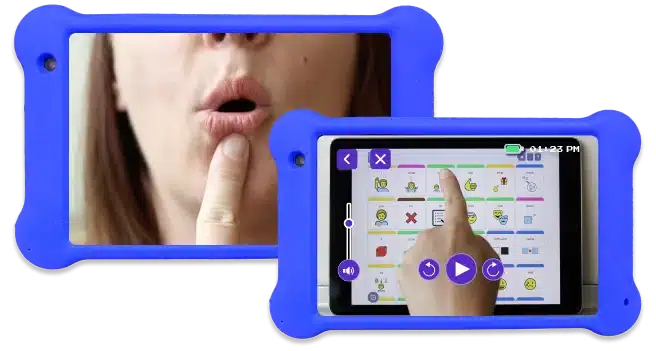When I work with children who have difficulty speaking or accessing their words, I often see parents relying on yes and no questions to understand what their child is trying to communicate. Many children with autism spectrum disorder and other neurodiverse profiles find these questions challenging, which makes communication even more complicated. As someone who works directly with these kids, I want to share effective strategies for teaching them to understand and respond to yes and no questions. This can greatly improve their ability to communicate and reduce frustration for everyone involved.
Table of Contents
Use Visual Support for Yes and No
Many children benefit from visual support to help them understand questions and to know which words to use to respond to those questions. When you ask your child a yes/no question, consider using gestures like pointing or showing items while you ask. This helps your child understand what you are asking about. Using a body movement like a head nod or thumbs up for yes and a head shake or thumbs down for no is also important to offer your child information on what the answer to the question should be. These visual support gestures are hints that can be faded over time, once your child learns to respond consistently on their own.
Read more: How to Help Your Child’s Speech at Home
Use Simple Yes/No Question Forms
When your child is learning something new, it is helpful to start with a simple structure, and then add variety as they are successful. Start your yes/no question practice with a simple question about something you know your child is interested in and has a preference for. For example, you might start your practice offering food or toy items that you know your child loves and asking a simple question like “Do you want _______?” while holding out the item. You’ll offer lots of support when you first start practice so that your child expresses the answer right away.
Teaching Yes-No Questions to Kids with Autism: Engaging and Effective Strategies
When it comes to teaching yes-no questions, including for children with autism, it’s helpful to start with questions that you already know your child’s likely answer to. This approach allows them to practice in a calm and motivated state, increasing engagement and learning. Here are some effective strategies to teach yes-no questions:

Read more: How to Communicate with a Nonverbal Autism Child
- Use Preferred Topics: Begin with questions related to your child’s preferred topics or activities. This enhances their interest and encourages active participation.
- Provide Visual Supports: Utilize visual aids like picture cards or visual schedules to reinforce the concept of yes-no questions and facilitate understanding.
- Model and Reinforce: Model the correct use of yes-no questions and provide positive reinforcement, such as praise or small rewards, for their responses.
- Use Interactive Games: Engage your child in interactive games or activities that involve answering yes-no questions, making the learning experience enjoyable and interactive.
- Practice in Different Contexts: Encourage your child to practice yes-no questions in various settings and with different people to generalize their skills.
Fade Your Support Over Time
When teaching yes-no questions to children with autism, it’s crucial to provide support initially, but also have a plan to promote independence early in the learning process. By following a structured approach, we can help children with autism and similar neurodiverse profiles develop the ability to respond to yes-no questions more independently.
It’s helpful to make a short mental or written list of the ways you want to teach and show your child with autism the meaning of yes/no questions and what they can do to respond. We discussed visual support above, which is one way to show meaning. Another form of support is to model the spoken answer using spoken words and/or pictured words on an augmentative communication (AAC) device or tool. Start out using as much of these supports as needed for your child to answer accurately and once you feel confident that they are getting the hang of it, try to practice with less support, and then less, until they are doing it all on their own.

Ivy had just started speaking, but her communication was still very minimal. Goally’s visual schedule and aac inspired Talker had me really interested. Goally has helped us offer our daughter a voice while she learns to find her own. The key is to support communication in whatever form that takes. " — Cassidy Learn more →
Teaching Yes/No Questions to Children with Autism: Strategies for Success
When it comes to teaching children with autism, repetition with variety is a valuable principle. This means providing frequent opportunities to practice answering yes/no questions, incorporating both repetitive and new practice sessions. By adding variety to the practice, such as changing the questions, gradually introducing more complex questions, and modifying the question structure, you can help your child develop flexible understanding.
Check out the examples of yes/no questions below to get started:
| Steps | Description |
|---|---|
| Step 1: Practice Yes with “Do you want_______?” | Offer your child an item they want, like crackers. Say ‘Yes’ while showing related gestures (head nod or thumbs up). Reduce support gradually until the child starts to answer independently. |
| Step 2: Practice No with “Do you want________?” | Offer your child an item they don’t want, like a tissue. Do similar practice as you did with [yes questions], this time teaching them to say ‘No’ and refusal gestures. |
| Step 3: Fade Support for Simple Questions | Increase opportunities for practicing simple ‘[yes questions]’ without visual gestures or spoken hints. Gradually challenge them with different forms of yes/no questions. |
| Step 4: Ask Different Types of Yes/No Questions | Broaden the scope of practice by introducing visually supported and unsupported complex ‘[yes question]’ phrases such as: “Is this”, “Are you” etc. Also offer absurd games to keep your child interested. |
| Step 5: Keep on Teaching through Feedback | If a mistake occurs, highlight it gently so they can correct themselves next time. Importantly, remember to model yes/no questions throughout their daily routine. After each session, always end on a successful note even if it means providing more support than before. |
Examples of Yes/No Questions
- Do you like ice cream?
- Is today Monday?
- Did you go to the park yesterday?
- Is your favorite color blue?
- Do you have a pet?
- Is it raining outside?
- Did you eat breakfast this morning?
- Is your teacher’s name Mrs. Smith?
- Did you watch a movie last night?
- Is your best friend’s name Sarah?
Goally | Apps To Support Child Development
Looking for fun ways to help your child learn life skills? Try Goally! The Goally tablet comes with award-winning learning apps and video classes to help kids develop the skills they need to become independent with FUN & evidence-based practices.

Our apps teach executive function, language, emotional regulation, finger dexterity skills, and more.
As your child develops new skills, you can increase the difficulty level of the tasks in the app to challenge and motivate them even further. This helps your child grow and progress at their own pace, while also keeping them engaged and excited about their development.

Remember, practicing yes/no questions with your child is an ongoing process that combines repetition and variety. With patience, consistency, and tailored support, you can help your child develop their understanding of yes/no questions and improve their communication skills.
FAQs About Teaching Yes and No to Children With Autism
What are effective methods for teaching yes and no to children with autism?
Using visual aids and consistent practice are effective methods for teaching yes and no to children with autism.
Why is it important to teach yes and no to children with autism?
Teaching yes and no helps children with autism communicate their needs and preferences more clearly.
How can visual schedules help in teaching yes and no?
Visual schedules can provide clear and consistent cues that help children with autism understand and use yes and no appropriately.
What role do rewards play in teaching yes and no?
Rewards can motivate children with autism to learn and use yes and no by reinforcing their correct responses.
How can parents practice yes and no with their autistic child?
Parents can practice yes and no through daily routines and interactive games, providing immediate feedback and reinforcement.
This post was originally published on 03/16/2022. It was updated on 07/19/2024.
Emily is a seasoned blog writer for Goally, leveraging her extensive background in child psychology and special education to provide valuable insights and resources for parents. Her commitment to understanding and addressing the unique needs of these children, combined with her expertise in educational strategies, makes her a credible and empathetic voice for families.





